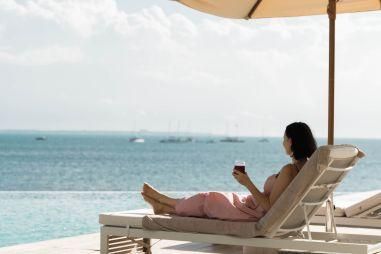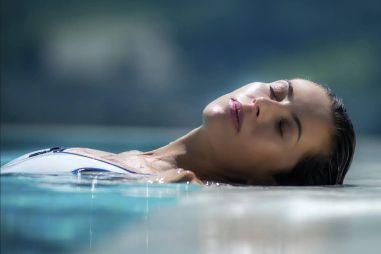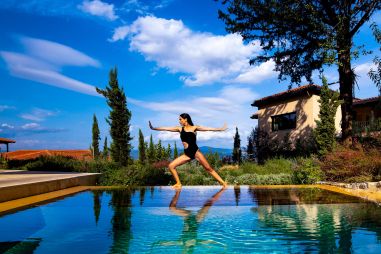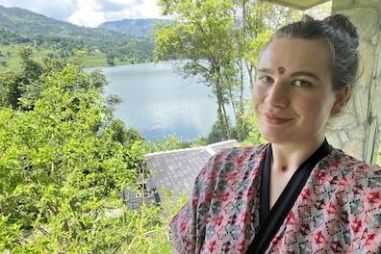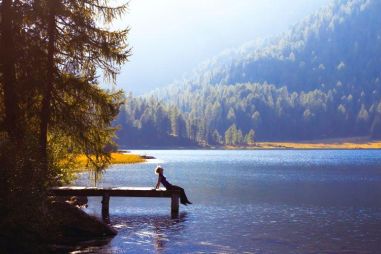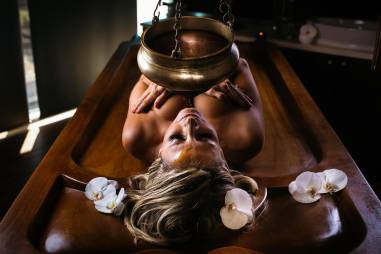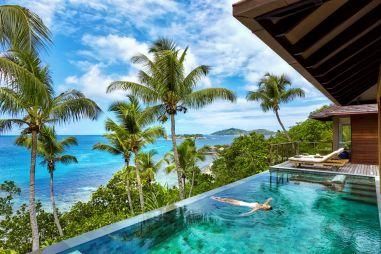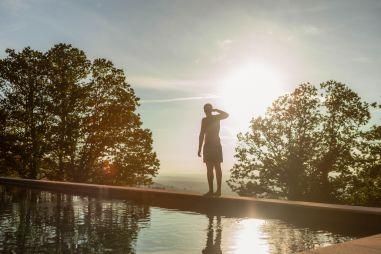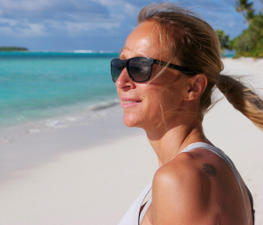Rejuvenation and renewal in Mexico
Ageing well and staying radiant is about far more than smoothing wrinkles. Nutrition, exercise, stress, hormones and your brain are just as crucial. Journalist Sarina Wijnen travelled to SHA, a medical spa in Costa Mujeres (Mexico), to follow a healthy ageing programme built around these core elements.
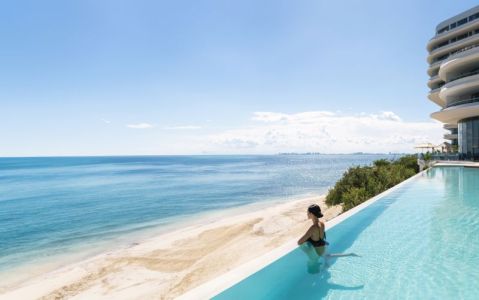
My love-hate relationship with aging
Getting older is complicated. On one hand, I genuinely enjoy being 49. I know myself, I know what works for me and what doesn’t, and I’m confident enough to say it out loud. I worry far less about what others think, which brings a sense of freedom and peace. Most importantly, I live more consciously, appreciating the present moment, grateful for what I have, and guided by my personal values. The physical side is trickier. I don't like the fine lines creeping in, and I dread the sagging skin that seems inevitable around my jaw and neck. Losing weight is no longer a matter of weeks, it can now take months. And then there’s my brain. Dementia runs in my father side of the family, and I can't help but worry about losing the sharp mind that has always brought me joy.
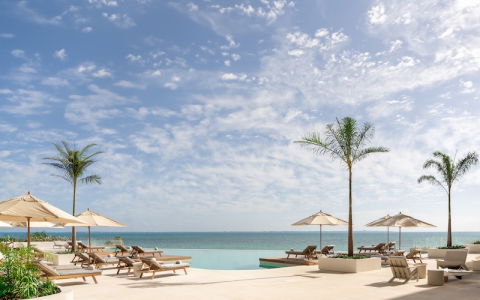
So when I was invited to cover SHA’s rejuvenation programme, I jumped at the opportunity. It felt like the perfect chance to reassess and adjust my lifestyle and habits before it’s too late. This five-star medical spa in Costa Mujeres is the sister location of SHA Spain, already well known in the wellness world. From the moment I arrived I see things that bring me joy: palm trees, turquoise waters and luxury suites set the scene. Their Advanced Longevity programme promises a fully holistic approach, including consultations on nutrition, exercise, stress management, hormones, cognitive health and aesthetic dermatology. I couldn’t wait to see what lessons it might hold about aging well.
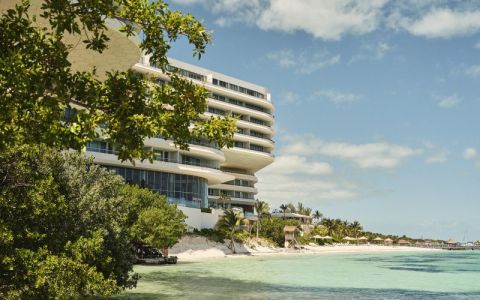
First consultations
The idyllic images on SHA’s website were accurate: sleek, minimalist hotel buildings, the Caribbean shimmering in front, and mangroves surrounding the property. My suite combines modern comfort with understated luxury, featuring a large terrace and a breathtaking sea view, where I will spend the week. After I've stowed away my suitcase, ‘Experience maker’ Sarah gives me a tour of the resort, showing the lounge, restaurant, infinity pool, rooftop gym with pool, and the chic spa tucked underground. The clinic itself spans six floors with lots of treatment rooms which feels like a maze at first, but the combination of clean lines, wood accents, and earthy tones made it welcoming.
The programme begins immediately, so I report to the wellness clinic. First, a nurse measures and weighs me, assesses my posture on a high tech rotating platform, and asks about my health. She sends the results to Dr Martinez, the clinic’s healthy aging doctor, who I meet after the tests. He starts with a compliment, I look great for 49. But quickly notes that I have too much fat and not enough muscle. “From thirty onwards, we lose about 1% of muscle mass each year,” he explains. “Which is why we have to train our muscles. Muscle is key to longevity: it boosts metabolism, circulation, hormones, insulin sensitivity, brain health, and even reduces cancer risk. Muscles are what I call a weapon of mass construction.” He recommends I lift heavy weights for at least half an hour, twice a week.
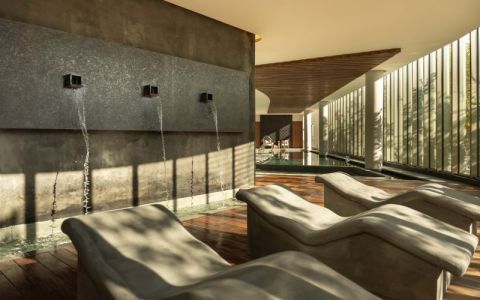
Next, I meet Gustavo, the programme planner, who shares SHA’s backstory with me. The founder had battled a rare cancer and during this treatment he met a doctor with a ton of knowledge on macrobiotic food and natural therapies. He combined this with his traditional treatments and recovered. His mission became raising awareness of healing nutrition, natural therapies, and cutting-edge Western medicine. Gustavo explains the healthy aging programme to me which is built around key foundations like movement, emotional wellbeing and aesthetic enhancements. "We can't stop aging, but we can slow it down", Gustavo states. Together we go through the programme, discuss the treatments and make some adjustments (I'd rather skip colonic cleanses, so I switch those for massages).
Nutrition is one of the key elements at SHA and also the subject of my final consultation of the day with dietitian Nelly. I tell her I want to lose a few kilos without starving myself while on holiday. We agree that for each meal I will choose from three set menus: Kushi (ultra-light, 1000 calories), Bio Light (medium, 1500 calories), and SHA (more culinary, 1800 calories). Restaurant staff are notified and will keep track of my choices. Nelly also advises to drink plenty of water, but not during meals, as it can hinder digestion. Lastly, she prescribes herbal teas to support my gut.
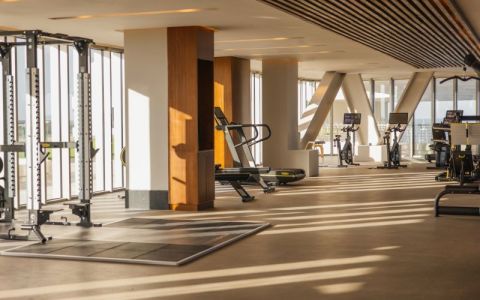
Work-out with a view
The next morning, after a refreshing rain shower and sunrise over the Caribbean—there’s no better way to be in the moment—I head to the gym. From here, I can admire the turquoise sea as I start a session with personal trainer Jorge. We start with a functional assessment, which basically means I do exercises while Jorge assess what areas I need to work on. Exercises like lunges with weights, squats with a ball, machine exercises for my back and arms, and core exercises. Jorge encourages me and counts along. After the work-out comes his assessment: my arms are strong, my fitness decent, but abs and thighs need more attention. This will be our focus for the week.
After the work-out I feel fully energised as I arrive at neuropsychologist Alba’s office, where she introduces me to ‘Brain Photobiomodulation’. It sounds like science fiction and honestly it feels a little like it too. I put on a helmet equipped with red LEDs that bathe my brain in light. The light stimulates brain cells which Alba says can improve overall cognitive health, including thinking , memory and concentration. It also helps reduce stress, worry, chronic pain and can improve sleep. The effects last about a week, and the session takes just twenty minutes in the chair with the helmet on. Alba suggests focusing on positive thoughts during the treatment to boost their activation-easy to do when you're in sunny Mexico, conducting experiments like this for work.
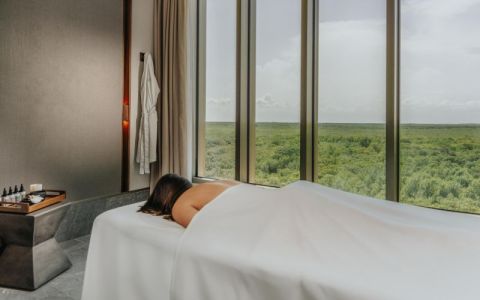
A good part of my programme focuses on pure relaxation and indulgence. It starts with an anti-cellulite treatment, for which I slip into a skin-tight suit while the therapist works specific areas of my body with a device. It feels like a deep massage and is surprisingly soothing. Immediately after comes the ‘Hydrogenetic Detox Cure’: half an hour in a warm bubble bath infused with essential oils, ending with a gentle facial massage. From there I am wrapped in clay before the bed beneath me inflates, lifting a few centimetres and surrounding me once more with warm, bubbling water. The sensation is almost womb-like, and I confess to the therapist that I could stay there for hours. After fifteen minutes she unwraps me and rinses the clay from my skin. I float back to the dressing room, feeling as though I were walking on clouds.
Evenings ended at Shamadi, the resort’s macrobiotic restaurant. The dishes look like edible art—picture-perfect and delicious, with a mix of Mediterranean and Japanese influences. The portions, however, are tiny. After just a few bites my plate is empty, and I rarely feel full. One evening I meet Sebastian, a flamboyant New York stylist who seems to have stepped straight out of Sex and the City. We click instantly, and when he reveals his solution to the hunger—a nightly stash of three snack boxes to take back to his room—I know I found a kindred spirit. ‘Nobody takes my snacks from me,’ he declares with theatrical flair. The next day I follow his lead and ask dietitian Nelly to add snacks to my daily plan.
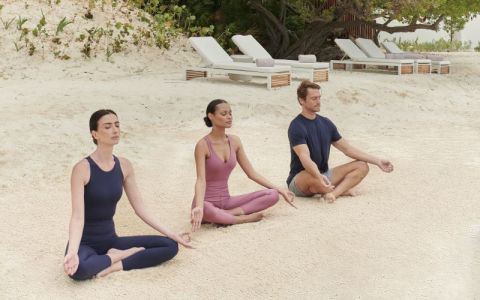
Breathe in, breathe out
The following days blend medical and relaxing therapies. One of the first is ozone therapy: a cheerful nurse draws my blood, mixes it with ozone, and re-infuses it, claiming it is good for almost everything—immunity, circulation, even infections. I also try cryotherapy, stepping into a small cabin where only my head sticks out while my body is blasted with minus 170-degree cold. The treatment is said to fight cellulite and give a mental boost, so I am determined to last the full three minutes. But the experience feels too claustrophobic, and after a few attempts I give up. Far more enjoyable is the Advanced Cell Regeneration Therapy, which I receive several times during my stay. For an hour I doze on an electronic bed that delivers static energy and ions to my body, a treatment my therapist describes as gently restoring organs and skin.
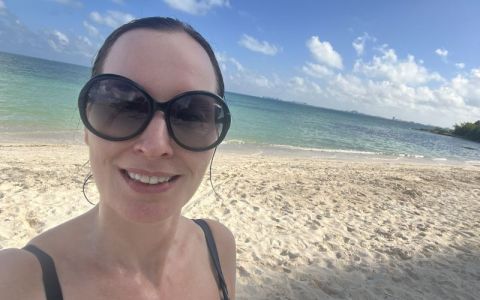
While the treatments are professional and hightech, the organisation behind the scenes is less flawless. Missed appointments, sudden schedule changes, and ongoing confusion about my meal plan tested my patience. One morning I arrive for a personal training session with Jorge, something I had been looking forward to, only to discover he was already with another client. The wellness reception tries to smooth things over, but it's the last straw. Instead of accepting their offer of a replacement massage, I walk straight to the beach. Barefoot on the sand, I let the ocean restore me. After a swim in the warm water, the tension lifts and I feel joy return.
I feel myself completely unwind during the private pranayama lesson. Isabel, the Mexican yoga teacher, radiates a calm, pure energy. She explains that pranayama, Sanskrit for breathwork, helps us navigate life’s ups and downs. "Our spirit is like a wild horse, running in every direction," she says. "Through breath work we hold the reins, choosing where to invest our energy and what to release." She asks if there was anything I want to focus on, and I admit I often feel overwhelmed by noise, chaos, and multitasking. Isabel introduces me to Brahmari, the humming bee breath. With thumbs pressed gently into my ears and fingers resting over closed eyes, I inhale deeply and exhale with a humming vibration. After six rounds my shoulders drop, and a deep calm washes over me. Isabel encourages me to pair the exercise with gratitude, a daily ritual I have continued ever since.
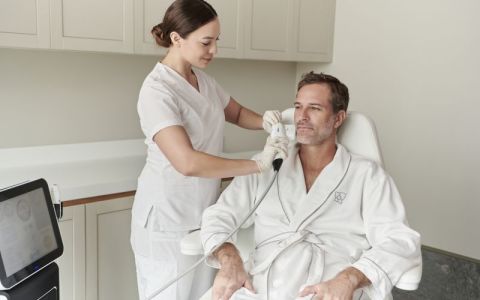
Glowing skin
I am curious about the aesthetic side of the programme. A cleansing facial with glycolic and salicylic acids clearly does its job—Sebastian immediately remarks on my glowing skin. After that comes a treatment for my neck and chest: Indiba, a radiofrequency therapy designed to firm the deeper layers of the skin. The session leaves me with a healthy glow, though I do not notice any real change in firmness. The beautician assures me this is normal, explaining that visible results require several treatments.
Next is my consultation with Dr Wong, SHA’s aesthetic doctor. As a lifelong skincare enthusiast, I am eager to hear his advice. We begin with my routine: cleansing with glycolic acid, a vitamin C serum, daily sunscreen, and a retinol night cream. He approves, but recommends adding supplements with vitamin C, vitamin E, and omega-3. He also suggests regular radiofrequency treatments to improve skin elasticity, especially around my jawline. For those seeking perfection, he adds, fillers could be considered. I ask about body care as well, mentioning that the skin on my arms no longer feels as soft as it once did. Dr Wong’s tip is to mix a 0.1% retinol cream with body lotion and apply it nightly. I carefully note down all his suggestions to review with my dermatologist back home.
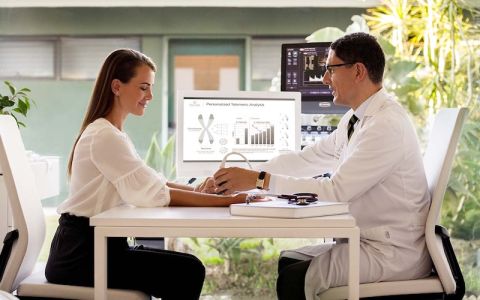 At the end of the week I meet Dr Martinez again to review the results of my blood and urine tests. Overall the picture is good: healthy cholesterol, strong blood vessels, and, to my surprise, still very fertile. But there's room for improvement. Several deficiencies show up, most notably folic acid and B12, which he links to my meat-free diet. Vitamin D, iron, zinc, chromium, manganese, growth hormone, and the adrenal hormone DHEA are also slightly low. Dr Martinez recommends a long list of supplements, emphasising the importance of folic acid and B12 to avoid potential neurological and cardiovascular risks. He also notes high leptin levels, which explains my frequent hunger and difficulty losing weight. His advice is to increase protein and healthy fats in my diet, or consider protein supplements, to feel fuller for longer. I am unsettled by both the warnings and the sheer number of supplements, and decide I would seek advice from my own doctors at home before committing.
At the end of the week I meet Dr Martinez again to review the results of my blood and urine tests. Overall the picture is good: healthy cholesterol, strong blood vessels, and, to my surprise, still very fertile. But there's room for improvement. Several deficiencies show up, most notably folic acid and B12, which he links to my meat-free diet. Vitamin D, iron, zinc, chromium, manganese, growth hormone, and the adrenal hormone DHEA are also slightly low. Dr Martinez recommends a long list of supplements, emphasising the importance of folic acid and B12 to avoid potential neurological and cardiovascular risks. He also notes high leptin levels, which explains my frequent hunger and difficulty losing weight. His advice is to increase protein and healthy fats in my diet, or consider protein supplements, to feel fuller for longer. I am unsettled by both the warnings and the sheer number of supplements, and decide I would seek advice from my own doctors at home before committing.In the rest of our appointment Dr Martinez focuses on brain health, something I worry about since dementia runs in my family. He reassures me that genetics are not as decisive as people think: lifestyle has far more influence. His key advice was simple but powerful: eat clean, avoid processed food, prioritise sleep, strength train regularly, and manage stress through practices like breathwork, meditation, or even cuddling animals. The bigger the animal, he added with a smile, the more energy is transferred so horses and dogs top his list.
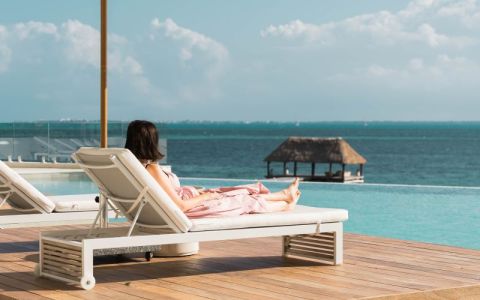
Taking stock
Months later, I’ve realised we have far more influence over how we age than we think. Nutrition, exercise, stress management, and skincare form the foundations. As Gustavo told me at the start, ‘Think of SHA as a university of health. You learn here so you can apply it at home.’ That’s exactly what I’ve done. Inspired by the focus on strength training, I now follow a personalised weights programme at my gym alongside group classes. I also began working with a dietitian on a tailored nutrition plan, because I wanted to eat healthier. Still, I make room for balance: a glass of wine, a slice of cake, or nights out with friends. Because joy is part of ageing well too.
I did not adopt all the supplements, as I had no desire to take handfuls of pills every day. Together with my doctor and pharmacist back home—who follow evidence-based medicine rather than SHA’s so-called ‘precision medicine’—I settled on B12, folic acid, zinc, and vitamin D. According to them, most of my other blood levels were within the normal range, and a healthy, varied diet should be enough.
And my skin? It glowed for weeks after the treatments, the massages, and simply being surrounded by ocean and nature. When that faded, my dermatologist recommended radiofrequency—also suggested by Dr Wong—but combined with microneedling for longer-lasting results.
Thanks to Isabel, I also returned to daily gratitude and breathwork practices, something I had known but let slip over time. In short, I came home determined to take better care of myself, both physically and mentally, with the long view in mind.
Experience SHA Mexico
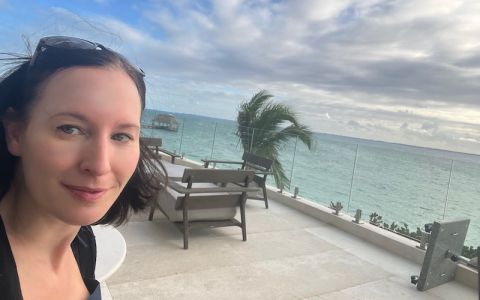
About Sarina
This blog was written by Sarina, a journalist who has been collaborating with Puurenkuur for many years. She first connected with us during a press trip to Kamalaya and has since explored numerous wellness destinations in Belgium and abroad. From her home base in Antwerp, she shares her experiences on her health and wellbeing journeys.
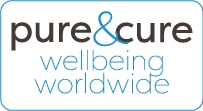
 EN
EN NL
NL BE
BE